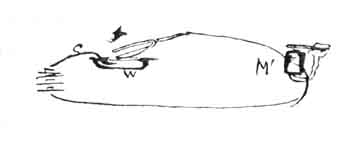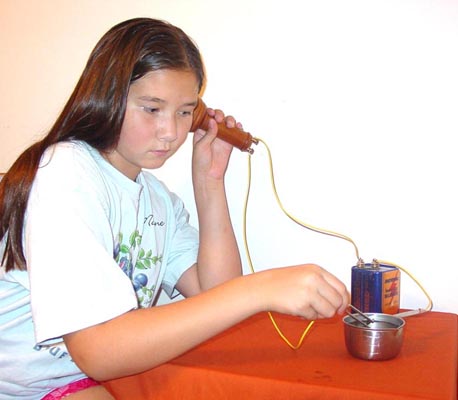
Telephone Science Experiment #1
Alexander Bellís Famous Tuning Fork Experiment
For over a year, Alexander Bell, at the urging of his financial backers, had been working diligently to perfect his multiple-message telegraph, a system that he believed would eventually transmit an astounding 30 to 40 simultaneous messages along a single telegraph wire. The telegraph industry would gladly pay a small fortune for just such a system.
But throughout this time he was also obsessed with an elusive dream -- that of sending the human voice over a telegraph wire. He had even made several unsuccessful attempts to do this. Now, in March of 1876, having just returned to Boston after a conference with his patent attorneys in Washington, D.C., he decided to try a new approach, one he had never pursued before.
He theorized that if he could somehow vary the resistance in an electrical circuit at the frequency of sound it would cause the current to fluctuate in exact step with the sound. And if he sent that fluctuating current through one of the electromagnetic relays he was using for his telegraph system, he should be able to hear the original sound coming from the relay. If he could do that, he believed, he was very close to sending the human voice through that same circuit. He sketched out this idea in his laboratory notebook as shown in Figure 1.

Figure 1
All he needed for the experiment was a tuning fork, a battery, a bowl filled with water and a little bit of acid (to make it electrically conductive), and a relay. The relay, Item M in Figure 1, would act as a crude earphone. With these components connected as shown, he held the relay tightly against his ear and then gave the tuning fork a sharp rap to make it vibrate. With the tuning fork still vibrating, he carefully lowered it, keeping it almost parallel with the liquid, so that just one tip barely touched the water/acid solution. To his great delight, he heard the exact pitch of the tuning fork coming from the relay pressed against his ear. He knew now that his elusive dream would soon be a reality.
You can easily perform this same experiment using the arrangement shown in Figure 2. Tuning forks can be obtained from music stores for about five dollars. A six-volt lantern battery works well. For the acid water use 5% white vinegar straight from the bottle and pour it into a 1-cup metal measuring cup. The listening device (used in place of Bellís relay) can be just about anything that can produce sound: an old telephone receiver, a headphone, a loudspeaker from an old radio, or a small replacement speaker (see Radio Shack). Connect these items as shown in Figure 2.

Figure 2
Be sure to give the tuning fork a good rap and then quickly lower it to the vinegar, keeping it as parallel as possible. Experiment to see just how far the tuning fork should enter the vinegar. Even though you canít see it, the tip of the vibrating tuning fork is being rapidly immersed and withdrawn from the vinegar. This changes the resistance between the fork and the vinegar, which in turn causes the current through the listening device to fluctuate at the same frequency of the fork. Try the experiment again, but with the fork perpendicular to the vinegar; you may not hear any sound because there is no change in resistance.
Written by Ed Evenson 2002, author of the book The Telephone Patent Conspiracy of 1876.
Return to Antique Telephone History page